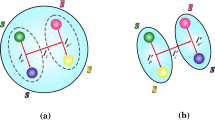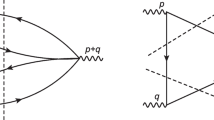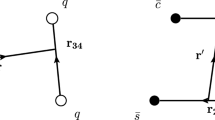Abstract.
This paper focuses on tetraquarks containing two heavy quarks in the formal limit where the heavy quark masses are taken to be arbitrarily large. There are well-established model-independent arguments for the existence of deeply bound exotic \( \bar{q}\bar{q}^{\prime}QQ\) tetraquark in the formal limit of arbitrarily large heavy quark masses. However, these previous arguments did not address the question whether tetraquark states exist close to the threshold for breaking up into two heavy mesons. Such states are not stable under strong interactions --they can emit pions and decay to lower-lying tetraquark states. This raises the issue of whether the nature of the heavy quark limit requires such states to exist as resonances that are narrow. Here we present a model-independent argument that establishes the existence of parametrically narrow tetraquark states. The argument here is based on Born-Oppenheimer and semi-classical considerations. The results derived here are only valid in a formal limit that is well outside the regime occurring for charm quarks in nature. However the analysis may give some insight in the experimentally observed narrow near-threshold tetraquark states containing a heavy quark and antiquark.
Similar content being viewed by others
References
F.-K. Guo, C. Hanhart, U.-G. Meißner, Q. Wang, Q. Zhao, B.-S. Zou, Rev. Mod. Phys. 90, 015004 (2018)
S. Godfrey, S.L. Olsen, Ann. Rev. Nucl. Part. Sci. 58, 51 (2008)
T.D. Cohen, Phys. Lett. B 427, 348 (1998)
H. Georgi, in Perspectives In The Standard Model (Tasi-91) (World Scientific, 1992) pp. 589--630
B. Grinstein, Int. J. Mod. Phys. A 15, 461 (2000)
S.L. Olsen, T. Skwarnicki, D. Zieminska, arXiv:1708.04012 (2017)
H.-X. Chen, W. Chen, X. Liu, S.-L. Zhu, Phys. Rep. 639, 1 (2016)
T.D. Cohen, P.M. Hohler, Phys. Rev. D 74, 094003 (2006)
A.V. Manohar, M.B. Wise, Nucl. Phys. B 399, 17 (1993)
S. Zouzou, B. Silvestre-Brac, C. Gignoux, J. Richard, Z. Phys. C 30, 457 (1986)
S. Scherer, in Advances in Nuclear Physics, Vol. 27 (Springer, 2003) pp. 277--538
A. Francis, R.J. Hudspith, R. Lewis, K. Maltman, Phys. Rev. Lett. 118, 142001 (2017)
P. Cho, Nucl. Phys. B 396, 183 (1993)
S.H. Lee, S. Yasui, Eur. Phys. J. C 64, 283 (2009)
M. Born, R. Oppenheimer, Ann. Phys. 389, 457 (1927)
M. Berwein, N. Brambilla, J.T. Castellà, A. Vairo, Phys. Rev. D 92, 114019 (2015)
N. Brambilla, W.K. Lai, J. Segovia, J.T. Castellà, A. Vairo, Phys. Rev. D 99, 014017 (2019)
N. Brambilla, G. Krein, J.T. Castellà, A. Vairo, Phys. Rev. D 97, 016016 (2018)
M. Gell-Mann, Nuovo Cimento 4, 848 (1956)
N. Brambilla, A. Pineda, J. Soto, A. Vairo, Nucl. Phys. B 566, 275 (2000)
G.T. Bodwin, E. Braaten, G.P. Lepage, Phys. Rev. D 51, 1125 (1995)
N. Christ, T. Lee, Phys. Rev. D 22, 939 (1980)
J. Schwinger, Phys. Rev. 127, 324 (1962)
A.P. Szczepaniak, E.S. Swanson, Phys. Rev. D 65, 025012 (2001)
H. Feshbach, Ann. Phys. 5, 357 (1958)
H. Feshbach, Ann. Phys. N.Y. 19, 287 (1962)
A. Ali, J.S. Lange, S. Stone, Prog. Part. Nucl. Phys. 97, 123 (2017)
Author information
Authors and Affiliations
Corresponding author
Additional information
Communicated by Shi-Lin Zhu
Data Availability Statement
This manuscript has no associated data or the data will not be deposited. [Authors’ comment: This paper is a theoretical analysis, so it does not produce any data.]
Publisher’s Note
The EPJ Publishers remain neutral with regard to jurisdictional claims in published maps and institutional affiliations.
Rights and permissions
About this article
Cite this article
Cai, Y., Cohen, T. Narrow exotic hadrons in the heavy quark limit of QCD. Eur. Phys. J. A 55, 206 (2019). https://doi.org/10.1140/epja/i2019-12906-0
Received:
Accepted:
Published:
DOI: https://doi.org/10.1140/epja/i2019-12906-0




